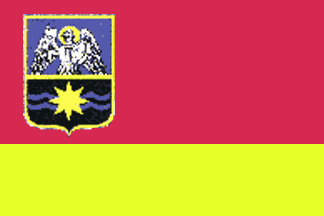 (5:8)
(5:8)image by Jens Pattke, 3 September 2005

Last modified: 2023-01-28 by martin karner
Keywords: kyyiv | kiev | kyiv | slavytych | slavutych | chernobyl |
Links: FOTW homepage |
search |
disclaimer and copyright |
write us |
mirrors
 (5:8)
(5:8)
image by Jens Pattke, 3 September 2005
See also:
Other Sites:
From the site of Ukrainian
Heraldry:
"The flag is rectangular with the size 160 cm in horizontal
direction and 100 cm in vertical direction. On a flag's field in
the left-hand upper corner apart 15 cm from above and 15 cm at
the left is the emblem of the city that has width 29 cm and
altitude 36 cm. The flag's field is divided into two parts. Upper
has 70 sm and crimson colour, lower part is yellow and has 30
sm."
Dov Gutterman, 18 November 2001
kv-sl.gif)
image from the site of Ukrainian Heraldry
From the site of Ukrainian
Heraldry:
"The shield per fess by azure and sable. In the upper part
is archangel Michael with raised sword. In the bottom part is or
eight-radial star, placed to the wave azure belts. Sable means
memory about Chornobyl' tragedy, azure means hope for the light
future. An or star is attempt to find a character of atomic
engineering instead of "models of atom ". Eight its
rays mean eight republics, which one have shared in building
city."
Dov Gutterman, 18 November 2001
From the site of Ukrainian
Heraldry:
"Slavytych was founded at 1986 in connection with Chornobyl'
nuclear failure."
Dov Gutterman, 18 November 2001
I think more correct name is Slavutych (or Slavutich). The
town of Slavutych was founded after Chernobyl tragedy for former
inhabitants of Chernobyl. Black colour on the CoA symbolizes the
memory of that terrible days.
Victor Lomantsov, 20 November 2001
Considering the complexities of this issue (cross equivalence
and identity of cyrillic letter usage in Russian and Ukrainian),
I guess the original spelling, in the cyrillic alphabet, would be
the only stable reference.
I seem to remember that the "Cherno-" preffix in that
name did not meant, as would be expected, "black". Is
this usage of black color a refute, a case of popular ethimology,
or just unrelated usage of black as mourning color?
Antonio Martins, 23 November 2001